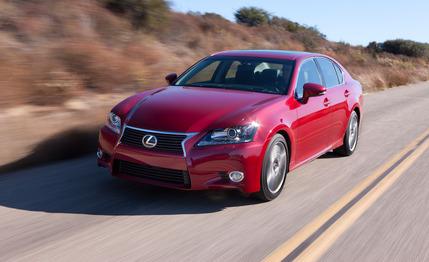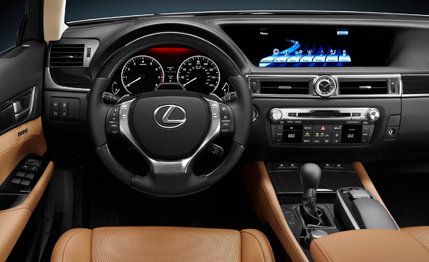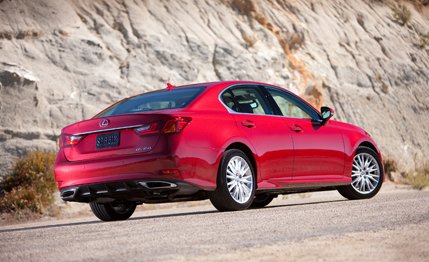
 First Drive Review
First Drive Review
Lexus wants us to believe that the 2013 GS is a different car from its predecessor—an evolved car, a bona fide sports sedan. As we poked, prodded, and drove the new GS350 and GS350 F Sport, we felt a bit like a parole officer trying to discern if our charge had truly changed its ways. Is the GS still an offender?
A clear outward sign of change is the GS’s exterior. Like most new cars with sporting pretensions, the GS has LED flourishes surrounding the headlamps (LED headlights are optional), a small amount of chrome, and a scowling front fascia. Opt for the F Sport version, and the wheels and the front-end scowl get larger. Although its wheelbase is the same as the 2011 model’s, the new GS is 0.7 inch wider and 0.7 inch longer than before. As the first production vehicle to receive Lexus’s new L-finesse styling, the GS isn’t immediately identifiable as a Lexus. It’s more aggressive than Lexuses of the past and reminds us a bit of an Infiniti.
Refined for the Traditional Lexus Buyer, Enlivened for the Rest of Us
If the GS looks a little like an Infiniti, it’s even more Infiniti-esque in its personality. Even the GS350 equipped with the Luxury package has a solid and direct feel, but there isn’t a sacrifice in ride comfort or practicality. Up front, aluminum control arms and knuckles lighten up the suspension, and the rear springs and shocks are now separate, which opens up more trunk space. It doesn’t take long to realize that the ride of the GS seems more elastic and compliant than before. Even the F Sport version, with its stiffer suspension and 19-inch wheels, is civilized. Chassis and road noise are kept in the distance, but engine sounds are brought to the forefront. Work the V-6 hard, and a resonator on the intake tract funnels the motor’s growls and snarls toward the cabin. The sound livens the experience without giving up much refinement. And if you’re the type of Lexus buyer who never stomps on the throttle, the engine will never raise its voice above a whisper.


Equipped with Toyota’s dual direct and port fuel injection, the 3.5-liter V-6 essentially carries over from the previous GS350. Lexus did find three more hp and three more lb-ft of torque, for new totals of 306 hp and 277 lb-ft; it’s good for, we figure, a 0-to-60-mph time of about 5.6 seconds. Extracting that sort of performance requires working the engine past its 4800-rpm torque peak, however, which is something most luxury buyers will rarely attempt. But the V-6 is willing and hums all the way to its redline, although more low-end torque would be welcome.
That low-end grunt will be available via the GS450h hybrid. Like the previous version, a gasoline engine is supplemented by electric motors. Unlike the previous GS hybrid, the 2013 model’s gasoline engine runs on the more-efficient Atkinson cycle. Despite a higher compression ratio (13.0:1 versus the previous 11.8:1) and a revised intake, the move to Atkinson cost the 3.5-liter V-6 six hp. The electric motors are unchanged but can be fed more electricity, thanks to the power-control unit’s greater cooling capacity. The extra juice available from the battery pack cancels out the loss of engine power, so total output remains at 338 hp. Although not exactly as powerful as its competitors’ V-8 offerings, the hybrid setup’s additional low-end torque should help the GS450h achieve 60 mph about 0.1 second quicker than the GS350. The car’s buyers likely will be more interested in the hybrid’s EPA estimated fuel economy of 29 city and 34 highway, however. The 2011 GS450h returned a far less impressive 22/25.
Dual Threat: Luxury and Sport
Drive the GS350 with comfort primarily in mind, and it will not disappoint. Comfy chairs, spacious accommodations, and an artfully decorated interior await front-seat passengers. Rear-seat occupants will find deeply scalloped and supportive seats and generous legroom. The instrument panel has—gasp!—an analog clock in place of Lexus’s trademark and seriously dated digital piece. Opt for navigation, and the GS comes with a massive 12.3-inch screen that serves as the gateway to Toyota’s Entune infotainment system. Pair your smartphone with the GS via Bluetooth or a physical connection, and you can access your Facebook, Bing, Pandora, OpenTable, and Yelp apps through the car. Although you can’t type in any Bing searches at speeds above 6 mph, the speech-recognition system will allow you to do a web search at higher velocities.


For those who want their GS extra sporty, the aforementioned optional F Sport model adds a firmer suspension, larger 14.0-inch front brake rotors, electronically controlled shocks, and the 19-inch wheels. The rims come wrapped with staggered summer rubber on rear-wheel-drive models, and AWD models get single-width, all-season rubber. Four-wheel steering and variable-ratio steering are optional, and although the four-wheel steering makes for extremely stable cornering, we found the conventional, two-wheel-steering version to be more playful and willing to swing its tail on command. We can’t imagine many GS owners will partake in such antics, but this Lexus does allow the stability control to be completely shut off. Clearly, someone at Lexus thinks its owners should have the choice to show off their drifting skills to fellow country clubbers.
To recap: In addition to the GS450h hybrid model (which will arrive mid-2012), buyers can choose between the GS350 and its base, Luxury, and F Sport models. All-wheel-drive versions will be available at launch, too. Pricing is yet to be determined, but we expect that Lexus will start the GS lineup at just below $50,000. Luxury versions are likely to require about $55,000; the GS350 F Sport and the hybrid are expected to be priced at about $60,000. Those window stickers would put the GS up against the six-cylinder BMW 5-series and Mercedes-Benz E-class, the juggernauts of the segment. The GS now has the moves to compete with those two German brands, and it hasn’t lost the quiet refinement we’ve come to expect of Lexus. The GS isn’t going to bore enthusiastic drivers, but it’ll be happy to bore you if you’re a boring driver.